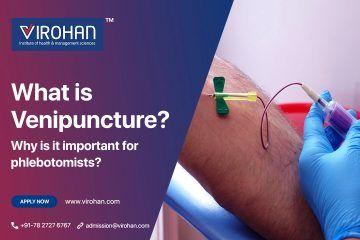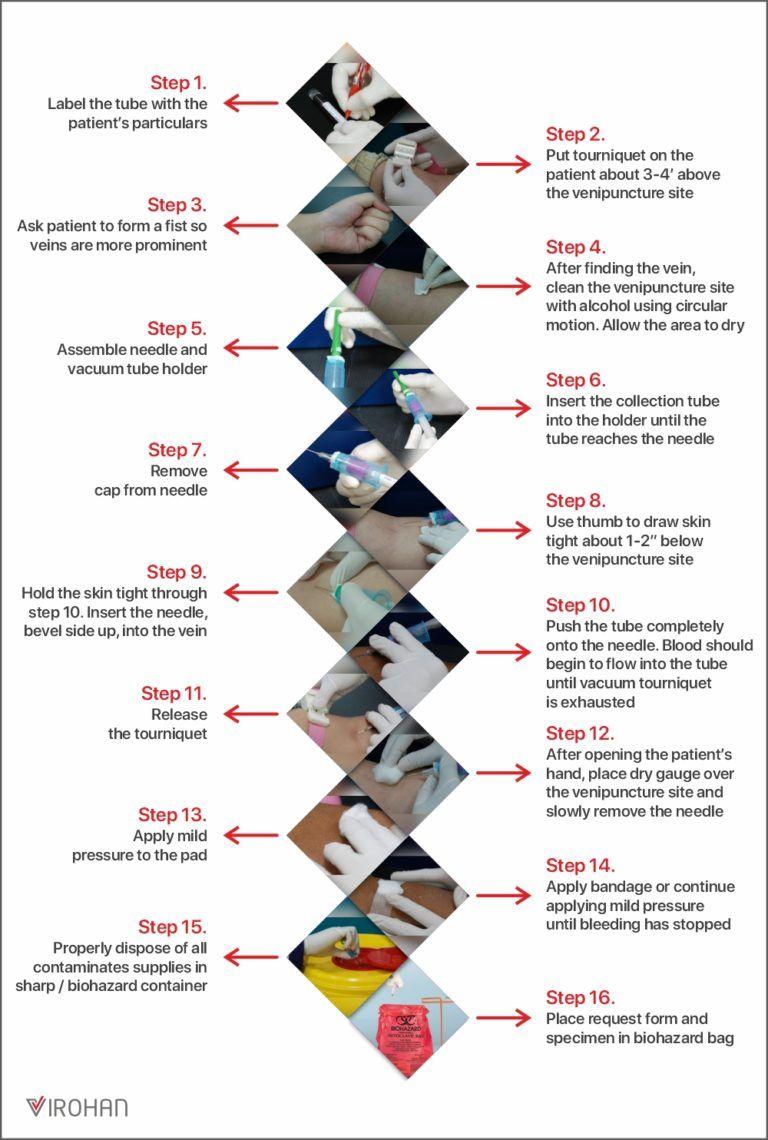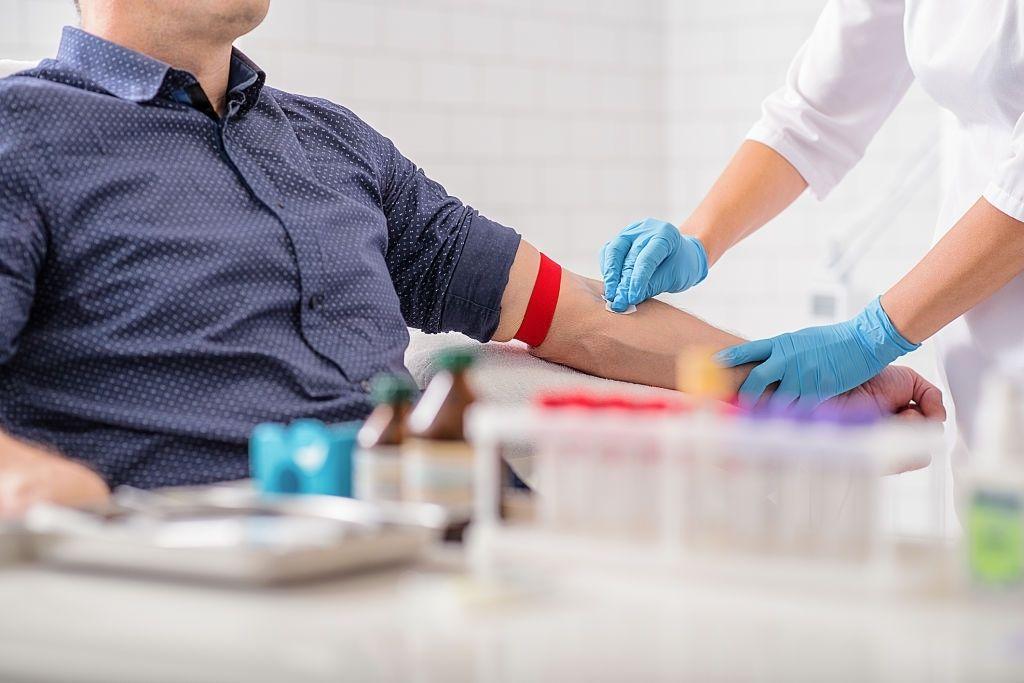Venipuncture, also known as venepuncture is a standard technique of insertion a needle inside the vein or intravenously, in order to draw blood from it. The process of drawing blood from a vein is called Phlebotomy. Thus venipuncture and phlebotomy go hand in hand – where one cannot be completed without the other.
What is Venipuncture
It is the act of puncturing a vein as a part of a medical procedure. The procedure facilitates obtaining intravenous access for the purpose of blood sampling. Also, it aids in intravenous therapy with fluids or medication for extended periods. It is the most commonly adopted method for phlebotomy procedures. Let us first deeply understand the term ‘Phlebotomy’
Also Read: B Voc Course
Venipuncture Procedure Outline:
1. Prepare the Patient
- Check the patient identification details.
- Verify the purpose of sample collection on the test report form.
- Make a note of the patient’s general conditions and do observe vital signs throughout the procedure.
- Clean the site with antiseptic and allow it to dry completely.
2. Labelling
- Label all the tubes with the patient’s particulars.
- All packets for transportation should carry legible labels.
Also Read: Medical Lab Technician Course
3. Practice all Precautions
- sterile needle/cannula.
- sterile cotton swabs to disinfect the skin.
- surgical spirit to wipe the puncture site.
- clean tourniquet to assess the location of the vein.
- Arrange sterile specimen bottles.
4. Drawing Blood
- Put an elastic band / tourniquet around the arm, 3-4 inches above the chosen site.
- The most suitable site for the collection of blood is the antecubital fossa, in the inner elbow area of the forearm.
- Ask the patient to close the fist.
- This will result in pressure that makes the vein swell with blood.
- Anchor the vein and make the skin taut 1-2 inches below the venipuncture site.
- Insert the needle with the bevel side up at an angle usually 15 to 30 degrees with the surface of the arm.
- Now perform venipuncture– draw blood.
- Collect blood in the tubes designated for the same.
- Tubes are colour-coded depending on additives in them for preserving the specimen.
- Tubes with anticoagulants should be inverted completely to facilitate complete mixing.
- This prevents the formation of any clots.
5. Hemostasis
- To restore blood pressure, ensure that bleeding stops.
- Remove the tourniquet as the last amount of blood is drawn.
- Slowly withdraw the needle, and cover the site of the puncture with a bandage.
- Keep applying mild pressure till bleeding stops.
6. Disposal
- Dispose off all sharps in specified containers.
7. Delivering Specimen
- Place specimens in leak-proof, biohazard packets for transportation.
- Samples collected outside the laboratories should be promptly delivered to the laboratory for interpretation.
8. Things to Remember
Here are some key points to be kept in mind while performing venipuncture.
- Use a new needle for every draw.
- Blood volume collection should be minimum.
- It varies with the age of a patient.
- It should not exceed 3-5% of the total blood volume.
- Do not place the tourniquet too tightly.
- It should not be held in place for more than 2 minutes to avoid any haemoconcentration.
- Always use a disposable band to prevent transmission of infection.
- Apply it just before starting the venipuncture procedure.
- Avoid the site for carrying out the puncture if it is scarred or burned.
- If the arm has a cannula or IV infusion, it should not be selected for puncture.
Also Read: OT Technician Course
Blood Collection Procedure
The process can be carried out by a lot of techniques, one of which is venipuncture. Phlebotomy is used for medical testing, to diagnose and treat a patient. It determines cholesterol, calcium and blood sugar levels etc.
Usually venipuncture is done in order to test the blood sample for certain conditions but at times it is done to treat certain medical conditions- drawing blood for treatment purposes is called therapeutic phlebotomy.
This is conducted in conditions such as:
- Hemochromatosis
- Polycythemia vera
- Porphyria cutanea tarda
- Sickle cell disease
- Nonalcoholic fatty liver disease
Blood Collection Method
1. Capillary/Finger Stick Sampling:
- The sample is obtained from a fingertip in adults and the heel in infants, to draw out small quantities of blood
- It is a fairly painless procedure done on pediatric and neonatal patients.
- Example – Routine blood sugar testing by glucometer
2. Arterial Sampling:
- In this procedure, the blood sample is collected from an artery in order to determine the arterial blood gases.
- Arterial sampling is performed by inserting a catheter placed in an artery, or by using a needle and syringe.
- Mostly the radial artery is used for the sampling.
Through arterial sampling we check oxygenation and the patient’s ventilation status.
3. Venipuncture Sampling:
- This technique is carried out to obtain blood used for diagnostic purposes- phlebotomy or can also be used in blood transfusion.
- Other purposes include removing excess levels of iron in the body and monitoring levels of specific components in blood.
- The technique is also conducted for the administration of medications or nutrition etc.
- It is favoured over arterial sampling as the walls of veins are thinner and easier to pierce.
Venipuncture Sites
Venipuncture sites are commonly found in the superficial veins of the upper limb –
- Median Cubital Vein: It lies in the anterior region of the elbow, within the cubital fossa, it is close to the surface of the skin and is an ideal option as it does not lie in close proximity to any large nerves.
- Cephalic Vein: found in the dorsal venous network of the hand. It ascends from the antero-lateral side of the upper limb, passing anteriorly at the elbow.
- Basilic and median antebrachial vein may also be used for the procedure.
venipuncture Materials
- Safety Needles Butterfly needles
- Syringes Vacutainer tube holder
- Transfer Device
- Blood Collection Tubes
- Tourniquets Antiseptic (70% isopropyl alcohol wipes)
- 2×2 Gauze
- Sharps Disposal
- Container
- Bandages or tape
Venipuncture CPT Code
The CPT code used for all venipuncture procedures is 36415
Venipuncture Biometric Screening:
Biometric screening using venipuncture is done in order to assess the patient’s vitals such as,
- blood pressure and pulse measurement
- fasting blood glucose levels
- blood cholesterol levels and triglycerides
During the screening procedure the blood is collected using a venipuncture technique, which is typically one or two vials of blood sample – Collected and tested in a laboratory to provide accurate measurements.
Venipuncture Importance for Phlebotomist
For a phlebotomist drawing blood samples is essential for the diagnosis of illness and adverse health conditions. Venipuncture is important for the technicians as:
- It is a faster method of collecting samples as compared to the capillary method.
- It allows multiple collections to be done. The technician can collect samples for various tests by performing a single puncture.
- Some tests can only be performed on venous blood. The presence of disease in a gland is tested by venous blood sampling.
- Veins have less muscular tissue than arteries. This facilitates phlebotomists to perform venipuncture with ease.
- There is less likelihood of any contamination with tissue fluids. In case of an episode of bleeding, it can be stopped quickly.
- The blood pressure in veins is lesser than in arteries. It is an important skill to be mastered in their career.
- The physicians and laboratorians depend on phlebotomists for quality samples to be collected.
- This aids the doctors to reach an accurate diagnosis, and thus devise the best treatment plan for the patient
Also Read: Hospital Administration Course


